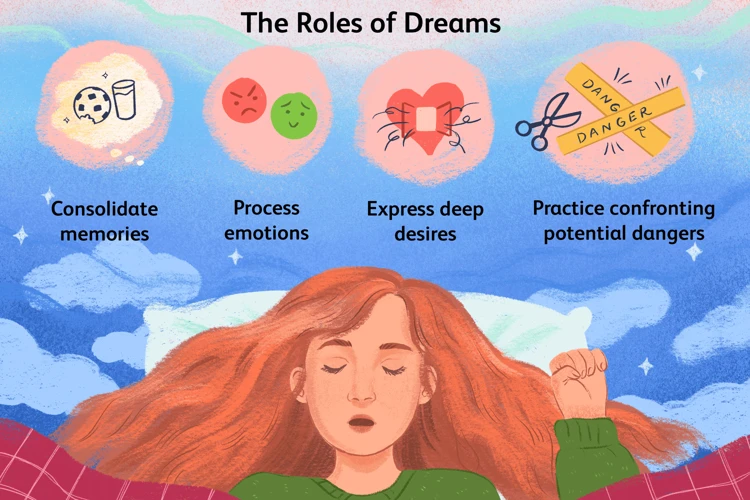Have you ever experienced the fascinating phenomenon of being fully aware and in control of your dreams? Lucid dreaming is a mysterious and captivating state where a person becomes conscious during their dreams, allowing them to actively participate and shape their dream experiences. But what if I told you that lucid dreaming could also have a significant impact on the quality of your sleep? In this article, we will delve into the world of lucid dreaming and explore its role in enhancing sleep quality. From understanding the basics of lucid dreaming to discovering techniques for inducing it, as well as tips for maintaining sleep quality, we will uncover the power of this extraordinary phenomenon in improving your overall sleep experience. So, get ready to unlock the secrets behind lucid dreaming and embark on a journey to a better night’s sleep!
The Basics of Lucid Dreaming

Lucid dreaming is a fascinating phenomenon that allows individuals to become fully aware and conscious within their dreams. It opens up a realm of possibilities where dreamers can actively engage and manipulate their dream experiences. Achieving lucid dreaming requires practice and the development of certain skills. One of the fundamental aspects of lucid dreaming is becoming familiar with the concept of reality testing. This involves regularly questioning the reality of your surroundings and critically examining whether you are dreaming or awake. Additionally, techniques such as meditation and mindfulness help in cultivating the level of awareness needed to recognize when you are in a dream state. Another effective approach is the wake-back-to-bed technique, where individuals wake up during the night, stay awake for a short period, and then go back to sleep with the intent of entering a lucid dream. By exploring the basics of lucid dreaming and adopting these techniques, you can enhance your ability to enter the extraordinary world of lucid dreaming. For more information on lucid dreaming techniques, follow this link.
What is Lucid Dreaming?
Lucid dreaming is a captivating phenomenon that occurs when a person becomes aware that they are dreaming while they are still in the dream state. It is like having a heightened sense of consciousness within the dream world. During a lucid dream, individuals are not only aware that they are dreaming, but they also have the ability to control and shape the events, characters, and environments within their dreams. This state of awareness allows people to engage in fantastical experiences, explore their imagination, and even develop new skills or overcome challenges in the dream realm. Lucid dreaming is often accompanied by a sense of empowerment and wonder, as individuals can actively participate and direct the course of their dreams. For those interested in exploring lucid dreaming as a tool for emotional healing, this article on exploring lucid dreaming for emotional healing provides valuable insights. However, like any skill, lucid dreaming may present its own set of challenges. To learn more about these challenges, you can refer to this article on lucid dreaming challenges.
How to Achieve Lucid Dreaming?
To achieve lucid dreaming, it is important to practice and develop certain techniques that can increase your chances of becoming aware within your dreams. One of the key methods is reality testing. This involves regularly questioning the reality of your surroundings by asking yourself, “Am I dreaming?” throughout the day. By making this a habit, you will train your mind to also question the nature of reality while you are dreaming. When performing reality tests, pay close attention to small details or inconsistencies that may indicate that you are in a dream. Another technique that can help induce lucid dreaming is meditation and mindfulness. These practices cultivate a heightened sense of self-awareness, making it easier for you to recognize when you have entered a dream state. Engaging in meditation and mindfulness exercises before bed or during the day can significantly increase your chances of lucid dreaming. Additionally, another effective method is the wake-back-to-bed technique. This involves setting an alarm to wake up after a few hours of sleep, staying awake for a short period, and then going back to sleep with the intention of entering a lucid dream. This technique takes advantage of the fact that dreams often occur during Rapid Eye Movement (REM) sleep, which happens more frequently in the latter half of the night. By waking up during this time and then going back to sleep, you are more likely to enter a dream state. Explore various lucid dreaming techniques to find the ones that work best for you and experiment with them to increase your chances of achieving lucid dreaming.
The Importance of Sleep Quality

Ensuring good quality sleep is crucial for maintaining overall physical and mental well-being. Sleep plays a vital role in our daily functioning, impacting our energy levels, cognitive abilities, mood, and overall health. By prioritizing sleep quality, we give our bodies and minds the opportunity to rest, restore, and rejuvenate. Poor sleep quality can lead to a range of negative effects, including increased stress levels, decreased immune function, impaired memory and concentration, and a higher risk of developing chronic conditions such as obesity, diabetes, and cardiovascular diseases. It is essential to understand the importance of sleep quality and take steps to improve it. Creating a sleep-friendly environment, establishing a consistent sleep routine, and practicing relaxation techniques are all effective strategies for optimizing sleep quality. By prioritizing adequate and restful sleep, we can enhance our overall well-being and lead healthier, more productive lives.
Why is Sleep Quality Essential?
Quality sleep is not just a luxury; it is essential for our overall well-being and functioning. Adequate and restful sleep plays a vital role in maintaining physical health, cognitive function, emotional well-being, and even our immune system. When we sleep, our body undergoes crucial restorative processes that promote healing, repair tissues, and regulate hormone levels. Poor sleep quality, on the other hand, can have detrimental effects on our health and daily performance. It can lead to fatigue, reduced concentration, impaired creativity, and memory problems. Chronic sleep deprivation has been linked to an increased risk of developing various health conditions, including obesity, diabetes, cardiovascular disease, and mental health disorders. By prioritizing and ensuring high-quality sleep, we give our bodies the opportunity to rest, recharge, and rejuvenate, ultimately leading to improved overall health and well-being.
Common Sleep Disorders
Sleep disorders are prevalent and can significantly impact a person’s overall well-being and quality of life. Here are some of the most common sleep disorders:
– Insomnia: Insomnia is characterized by difficulty falling asleep, staying asleep, or experiencing non-restorative sleep. It can result from various factors such as stress, anxiety, or underlying medical conditions.
– Sleep Apnea: Sleep apnea is a disorder where a person’s breathing repeatedly stops and starts during sleep. This interruption in breathing can lead to disturbed sleep and excessive daytime sleepiness. It is often caused by the throat muscles relaxing and blocking the airway.
– Narcolepsy: Narcolepsy is a neurological disorder that affects the brain’s ability to regulate sleep-wake cycles. People with narcolepsy experience excessive daytime sleepiness, sudden loss of muscle control (cataplexy), and hallucinations while falling asleep or awakening.
– Restless Legs Syndrome (RLS): RLS is characterized by an irresistible urge to move the legs, usually caused by uncomfortable sensations such as tingling or crawling. These sensations worsen at rest, making it difficult to fall asleep and stay asleep.
– Parasomnias: Parasomnias are a group of disorders that involve abnormal behaviors or experiences during sleep. Examples include sleepwalking, sleep talking, night terrors, and REM sleep behavior disorder (RBD), where individuals act out their dreams.
– Circadian Rhythm Disorders: Circadian rhythm disorders are disruptions in the body’s natural sleep-wake cycle. Shift work disorder, jet lag, and delayed sleep phase disorder are common examples, resulting in irregular sleep patterns and difficulty maintaining proper sleep schedules.
It is essential to recognize and address these sleep disorders to ensure optimal sleep quality and overall well-being. Seeking professional help from healthcare providers can lead to effective diagnosis and appropriate treatment plans tailored to specific sleep disorders.
The Role of Lucid Dreaming in Sleep Quality

Lucid dreaming not only offers a fascinating experience, but it also plays a significant role in improving the quality of our sleep. One of the main benefits of lucid dreaming is the ability to actively participate and control our dream scenarios, which can lead to a sense of empowerment and fulfillment. By having more positive and enjoyable dream experiences, we can wake up feeling more refreshed and satisfied, positively impacting our overall sleep quality. Lucid dreaming can serve as a tool for overcoming sleep disorders such as nightmares and sleep paralysis. It offers an opportunity to confront and conquer these distressing experiences, turning them into more pleasant and manageable dream situations. Embracing the world of lucid dreaming can truly transform our sleep patterns, promoting better rest and rejuvenation. Learn more about how lucid dreaming can contribute to emotional healing by following this link.
Benefits of Lucid Dreaming
Lucid dreaming offers a plethora of benefits that go beyond just the excitement of controlling your dream world. Here are some of the remarkable advantages of lucid dreaming:
1. Enhanced Creativity: Lucid dreaming allows your creative juices to flow freely. You can explore and experiment with various scenarios, landscapes, and ideas that may inspire your waking life creativity. Artists, writers, and musicians often draw inspiration from their lucid dreams, as they can vividly experience and interact with their imaginative creations.
2. Overcoming Fears and Nightmares: Lucid dreaming provides an empowering way to confront and overcome fears and nightmares. By becoming aware that you are dreaming, you can consciously face your fears, transform them, or even practice coping mechanisms within the safety of your dream environment. This can have a positive impact on your confidence and well-being in both your dream and waking life.
3. Emotional Healing: Lucid dreaming can be a powerful tool for emotional healing. During lucid dreams, you have the opportunity to revisit past experiences, confront unresolved emotions, and work through psychological challenges. This process can lead to emotional release, insight, and facilitate healing and personal growth.
4. Skill Improvement: Lucid dreaming can be utilized as a platform for practicing and improving real-life skills. Studies have shown that engaging in lucid dreams can have a positive impact on motor skills, athletic performance, and even academic learning. By rehearsing specific actions or scenarios in the dream world, individuals can enhance their abilities in the waking world.
5. Problem Solving and Decision Making: Lucid dreaming offers a unique space for problem-solving and decision-making. By consciously exploring different outcomes and possibilities within a dream, you can gain valuable insights and perspectives that may assist you in finding solutions to real-life challenges. Lucid dreaming can foster a sense of clarity and creativity when it comes to making important decisions.
It’s important to note that the benefits of lucid dreaming may vary from person to person. Some individuals may naturally experience more profound or specific advantages depending on their personal goals and desires. Nevertheless, engaging in lucid dreaming consistently can provide numerous positive impacts on various aspects of life.
Lucid Dreaming and Sleep Disorders
Lucid dreaming has shown promise in its potential to aid in the management of various sleep disorders. One such disorder is nightmares, which can cause distress and disrupt sleep patterns. Studies have found that individuals who practice lucid dreaming techniques can effectively confront and transform their nightmares into more positive dream experiences. By becoming aware that they are in a dream, lucid dreamers can actively change the narrative of their dreams, providing relief from recurring nightmares.
Sleep paralysis is another sleep disorder that can be alleviated through lucid dreaming. This condition involves being temporarily unable to move or speak while transitioning between sleep and wakefulness. It can be a terrifying experience, but lucid dreaming offers a solution. By recognizing the signs of sleep paralysis within a dream, lucid dreamers can regain control and transform the experience into a more positive one.
Insomnia, characterized by difficulty falling asleep or staying asleep, can also be influenced by lucid dreaming practices. Engaging in lucid dreaming exercises can help individuals cultivate a sense of relaxation and calm before sleep, allowing for a smoother transition into restful states of slumber.
Lucid dreaming has shown potential in reducing symptoms of sleep apnea, a condition where breathing briefly stops during sleep. While more research is needed, preliminary studies suggest that practicing lucid dreaming techniques could potentially assist individuals in maintaining breathing stability during sleep.
It is important to note that while lucid dreaming may provide benefits for certain sleep disorders, it is not a substitute for medical treatment or professional advice. Individuals experiencing sleep disorders should consult with a healthcare provider for proper diagnosis and treatment options. However, incorporating lucid dreaming techniques into a comprehensive approach to managing sleep disorders may offer additional support and potential relief.
Techniques for Inducing Lucid Dreaming

Lucid dreaming offers a gateway to a world where the boundaries of reality are blurred, and anything becomes possible. While achieving lucid dreaming may seem elusive, there are various techniques that can help induce this extraordinary state. Reality testing is a key technique where you question your surroundings to determine whether you are dreaming or awake. By performing reality checks throughout the day, such as looking at your hands or trying to push your finger through your palm, you can develop the habit of questioning your reality even in your dreams. Meditation and mindfulness practices can also enhance your ability to stay present and aware, increasing the likelihood of recognizing when you are dreaming. Additionally, the wake-back-to-bed technique involves setting an alarm to wake up during the night, staying awake for a short period, and then going back to sleep with the intention of entering a lucid dream. By incorporating these techniques into your routine, you can enhance your chances of entering the captivating realm of lucid dreaming.
Reality Testing
Reality testing is a crucial technique in the practice of lucid dreaming. It involves regularly questioning the reality of one’s surroundings to determine if they are in a dream state or awake. By incorporating reality testing into your daily routine, you can increase your chances of becoming aware during your dreams. Here are some effective methods to conduct reality testing:
1. Hand Examination: Throughout the day, take a moment to closely examine your hands. Look for any unusual features or deformities. In dreams, your hands may appear distorted or have more or fewer fingers than usual. By making a habit of checking your hands, you will cultivate the habit of doing the same while dreaming.
2. Reading Text: Try reading a passage of text, such as a book title or a sentence, and then look away. In dreams, the text often changes or becomes unreadable when looked at again. If you notice any inconsistencies or changes in the text, it may be an indication that you are in a dream.
3. Light Switches: Pay attention to light switches in your waking life and develop the habit of flicking them on and off. In dreams, light switches may not work as expected. If you find that the lights do not change or behave differently when flipping a switch, it may suggest that you are dreaming.
4. Reflections: Take a moment to observe your reflection in mirrors or other reflective surfaces. In dreams, reflections may appear distorted or unclear. By looking for any abnormalities or unusual appearances, you can strengthen your ability to recognize when you are dreaming.
Remember, consistency is key when it comes to reality testing. Make it a habit to perform these checks throughout the day. Eventually, this habit will carry over into your dream world, increasing the likelihood of becoming lucid. Incorporating reality testing into your routine is an essential step towards achieving and enhancing your lucid dreaming experiences.
Meditation and Mindfulness
Meditation and mindfulness play a crucial role in the practice of lucid dreaming. These techniques involve cultivating a state of focused attention and present-moment awareness, which can significantly improve the chances of becoming lucid within a dream. By regularly practicing meditation and mindfulness during waking hours, individuals develop a heightened level of self-awareness that carries over into their dream state. This increased awareness allows them to recognize the subtle cues and inconsistencies that indicate they are in a dream. During meditation, individuals learn to quiet the mind and let go of distracting thoughts, which can carry over to their dreams as well. This mental clarity and calmness promote a sense of control and stability within the dream realm, making it easier to recognize and manipulate dream elements. Additionally, mindfulness practices help individuals become more attuned to their thoughts, emotions, and sensations, both in waking life and in dreams. This awareness can lead to a deeper understanding of dream symbolism and facilitate the exploration of one’s inner world. By incorporating meditation and mindfulness practices into their daily routine, aspiring lucid dreamers can enhance their self-awareness, improve dream recall, and increase the likelihood of experiencing lucid dreams.
Wake-Back-to-Bed Technique
The Wake-Back-to-Bed (WBTB) technique is a powerful method to induce lucid dreaming. It involves waking up from sleep in the middle of the night and then going back to bed with the intention of entering a lucid dream. Here’s a step-by-step breakdown of how the WBTB technique works:
1. Set an alarm: Set an alarm to wake you up after approximately 4-6 hours of sleep. This timing is crucial as it targets the period when REM sleep, the stage where dreams occur, is more frequent.
2. Stay awake: Once the alarm goes off, resist the temptation to go back to sleep immediately. Instead, get out of bed and engage in activities that promote wakefulness. You can read a book, write in a dream journal, or simply walk around for 20-30 minutes. The key is to keep your mind alert while allowing your body to relax.
3. Visualize lucid dreaming: During the awake period, visualize yourself becoming aware and in control of your dreams. Imagine the excitement and possibilities that come with lucid dreaming. This visualization helps to reinforce your intention and primes your mind for the upcoming lucid dream.
4. Return to bed with awareness: After the wakeful period, go back to bed with the intention of entering a lucid dream. Focus your attention on your goal and maintain a sense of awareness as you drift back to sleep. You can use affirmations or mentally repeat a mantra related to lucid dreaming.
5. Induce a lucid dream: With the WBTB technique, there’s a higher likelihood of entering a lucid dream as you transition back into sleep. As you fall asleep, be receptive to any signs or cues that indicate you are dreaming. This heightened awareness can help you recognize the dream state, leading to a lucid dream experience.
Remember, the WBTB technique requires some practice and experimentation to find the ideal duration for staying awake and the most effective approach for inducing lucid dreams. It may not result in immediate success, but with persistence and consistency, you can harness the power of the WBTB technique to increase your chances of experiencing lucid dreaming.
Tips for Maintaining Sleep Quality
Ensuring a good night’s sleep is essential for overall well-being and productivity. To maintain optimal sleep quality, it is crucial to create a sleep-friendly environment. This includes keeping your bedroom dark, quiet, and at a comfortable temperature. Additionally, establishing a consistent sleep routine, with regular bedtimes and wake-up times, helps regulate your internal clock and promote restful sleep. Practicing relaxation techniques, such as deep breathing exercises or gentle stretching before bedtime, can also aid in preparing your body and mind for sleep. It is important to avoid stimulating activities, such as excessive screen time or consuming caffeine, close to bedtime, as they can disrupt your sleep patterns. By implementing these tips and prioritizing sleep, you can significantly enhance the quality of your sleep and wake up feeling refreshed and rejuvenated.
Create a Sleep-Friendly Environment
– Keep Your Bedroom Dark: Make sure your bedroom is a haven of darkness when it’s time to sleep. Use blackout curtains or blinds to block out any external light sources that may disrupt your sleep. You can also consider using an eye mask to create complete darkness and promote melatonin production, which is essential for a good night’s sleep.
– Maintain a Cool Temperature: A cool room temperature is conducive to quality sleep. Set your thermostat to a comfortable and cool setting, usually between 60-67 degrees Fahrenheit (15-19 degrees Celsius). Experiment with different temperatures to find what works best for you and create an optimal sleep environment.
– Minimize Noise Disturbances: Noise can be a significant disruptor to a peaceful sleep. Use earplugs or consider utilizing white noise machines or apps to drown out any disturbing sounds. These devices can create a soothing background noise that masks other disruptive sounds, helping you relax and fall asleep faster.
– Invest in a Comfortable Mattress and Pillows: The quality of your mattress and pillows directly affects your sleep quality. Invest in a mattress and pillows that are comfortable and supportive for your specific sleep needs. Remember to replace them regularly to maintain their integrity and ensure you have optimal comfort and support while you sleep.
– Declutter and Organize: A cluttered and chaotic bedroom can contribute to a restless mind. Take the time to declutter and organize your sleeping space, creating a calm and peaceful atmosphere. Remove any unnecessary items or belongings that may distract you or create a sense of disorder. Keeping your bedroom tidy promotes a clear and relaxed state of mind, ideal for a restful night’s sleep.
Creating a sleep-friendly environment is essential for improving sleep quality. By implementing these tips and optimizing your sleep environment, you can create the perfect sanctuary for rest and rejuvenation. Remember, a peaceful and comfortable sleep environment sets the stage for a night of deep and restorative sleep, allowing you to wake up refreshed and ready to tackle the day.
Establish a Consistent Sleep Routine
Establishing a consistent sleep routine is crucial for improving sleep quality. When it comes to optimizing sleep, our bodies thrive on regularity and consistency. Here are some key steps to help you establish a consistent sleep routine:
1. Set a consistent bedtime and wake-up time: Going to bed and waking up at the same time each day, even on weekends, helps regulate your body’s internal clock. This consistency trains your body to know when it’s time to sleep and when it’s time to wake up.
2. Create a pre-sleep routine: Engaging in relaxing activities before bed can signal to your body that it’s time to unwind and prepare for sleep. Consider activities such as reading a book, taking a warm bath, or practicing gentle stretches. Avoid stimulating activities, bright screens, and caffeine close to bedtime.
3. Create a sleep-friendly environment: Make your bedroom a peaceful and comfortable space that promotes relaxation and sleep. Keep the room dark, quiet, and at a cool temperature. Consider using earplugs, an eye mask, or white noise machines to block out any disturbances.
4. Limit exposure to screens before bed: The blue light emitted by electronic devices can interfere with your sleep-wake cycle. Try to limit screen time at least an hour before bed, or use blue light filters on your devices. Instead, engage in calming activities such as reading or listening to soothing music.
5. Avoid stimulating substances: Avoid consuming caffeine, nicotine, and alcohol close to bedtime. These substances can disrupt your sleep patterns and decrease sleep quality.
By following these steps and establishing a consistent sleep routine, you can train your body to associate certain cues with sleep, making it easier to fall asleep and stay asleep throughout the night. Consistency is key when it comes to optimizing sleep quality. For more tips on improving sleep quality, refer to our article on exploring the role of lucid dreaming in emotional healing.
Practice Relaxation Techniques
Practice Relaxation Techniques:
Relaxation techniques can play a vital role in enhancing sleep quality and promoting lucid dreaming. Engaging in relaxation exercises before bedtime helps calm the mind, release tension, and prepare the body for a deep and restful sleep. One effective technique is progressive muscle relaxation, which involves systematically tensing and then relaxing each muscle group in the body. Starting from the toes and working your way up to the head, tense each muscle group for a few seconds before releasing the tension and allowing the muscles to relax fully. This technique not only promotes physical relaxation but also increases body awareness, making it easier to recognize the sensations and signs associated with entering a lucid dream. Additionally, deep breathing exercises, such as diaphragmatic breathing or the 4-7-8 technique, can help induce a state of relaxation and reduce anxiety or stress that may disrupt sleep. Incorporating practices like yoga or gentle stretching into your pre-sleep routine can further promote relaxation and flexibility, relieving any tension accumulated throughout the day. By dedicating time to practice relaxation techniques, you set the stage for a peaceful and rejuvenating sleep, while also increasing your chances of experiencing lucid dreams.
Conclusion
In conclusion, lucid dreaming holds immense potential in enhancing sleep quality by providing a range of benefits. By actively participating and controlling dream experiences, individuals can use lucid dreaming as a tool for emotional healing, problem-solving, and creative inspiration. Moreover, for those suffering from sleep disorders such as insomnia or nightmares, lucid dreaming can offer relief and a way to reframe negative dream experiences. However, it is essential to note that achieving lucid dreaming requires patience, practice, and the adoption of various techniques like reality testing, meditation, and the wake-back-to-bed method. Additionally, maintaining overall sleep quality is crucial for reaping the benefits of lucid dreaming. Establishing a sleep-friendly environment, following a consistent sleep routine, and practicing relaxation techniques all contribute to better sleep. So, consider incorporating lucid dreaming techniques into your sleep regimen and immerse yourself in the potential for self-discovery and improved sleep quality. With time and dedication, you can unlock the wonders of lucid dreaming and embark on a journey of enhanced sleep experiences.
Frequently Asked Questions
What is the purpose of lucid dreaming?
The purpose of lucid dreaming is to gain conscious control and awareness within the dream state. It allows individuals to actively participate in their dreams, explore their subconscious mind, and even influence the dream narrative.
Can anyone learn to lucid dream?
Yes, anyone can learn to lucid dream with practice and patience. It may take time to develop the necessary skills and techniques, but with dedication, almost anyone can experience lucid dreaming.
Are there any benefits to lucid dreaming?
Yes, lucid dreaming offers several benefits. It can enhance creativity, provide opportunities for self-discovery, offer emotional healing, and even be used for problem-solving and rehearsing skills.
Is lucid dreaming linked to better sleep quality?
Yes, lucid dreaming can contribute to better sleep quality. It allows individuals to engage in more fulfilling and engaging dream experiences, potentially leading to improved rest and relaxation during sleep.
Can lucid dreaming help with overcoming nightmares?
Absolutely, lucid dreaming can be a valuable tool for overcoming nightmares. When individuals are aware they are dreaming, they can actively change the dream narrative or confront and resolve the source of their nightmares, leading to reduced fear and anxiety surrounding sleep.
Is lucid dreaming safe?
Lucid dreaming is generally considered safe, as it is a natural part of the sleep cycle. However, it is essential to approach lucid dreaming with a balanced mindset and not overly obsess or rely excessively on lucid dreaming to the detriment of other aspects of life.
How long does it take to achieve lucid dreaming?
The time it takes to achieve lucid dreaming varies from person to person. Some individuals may experience lucid dreaming within a few weeks of practice, while others may take several months or longer. Consistency and perseverance are key.
Can lucid dreaming be used for spiritual exploration?
Yes, lucid dreaming can be used as a tool for spiritual exploration. It provides a unique opportunity to connect with the subconscious mind, explore spiritual realms, and gain insights into one’s personal beliefs and spirituality.
Are there any potential challenges or drawbacks to lucid dreaming?
While lucid dreaming can be a rewarding experience, it may come with challenges. Sleep disruption, false awakenings, and difficulty distinguishing between dreams and reality are some potential challenges. It is crucial to maintain a healthy balance between wakefulness and sleep.
Can lucid dreaming be learned through online resources and guides?
Yes, there are several online resources, guides, and communities dedicated to teaching and sharing information on lucid dreaming. These resources can provide valuable insights, techniques, and support to help individuals learn and master the art of lucid dreaming.








